

Orosirian. The latter half of the period was an episode of intensive orogeny on virtually all continents.
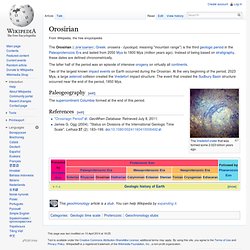
Two of the largest known impact events on Earth occurred during the Orosirian. At the very beginning of the period, 2023 Mya, a large asteroid collision created the Vredefort impact structure. The event that created the Sudbury Basin structure occurred near the end of the period, 1850 Mya. Paleogeography[edit] References[edit] "Orosiriagn Period". Orogeny. Physiography[edit] Continental collision of two continental plates to form a collisional orogen.
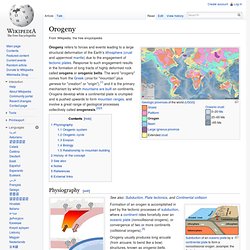
However, usually no continental crust is subducted, only uplifted. (example: the Alps) Formation of an orogen is accomplished in part by the tectonic processes of subduction, where a continent rides forcefully over an oceanic plate (noncollisional orogens), or convergence of two or more continents (collisional orogens).[5] Frequently, rock formations that undergo orogeny are severely deformed and undergo metamorphism. An orogenic event may be studied as: (a) a tectonic structural event, (b) as a geographical event, and (c) a chronological event. Orogenic system[edit] An orogeny produces an orogenic system, or (mountain) range-foredeep-foreland system. Orogenic cycle[edit] Although orogeny involves plate tectonics, the tectonic forces result in a variety of associated phenomena, including magmatization, metamorphism, crustal melting, and crustal thickening.
Erosion[edit] Biology[edit] H.J. Impact event. Artist's impression of a major impact event.
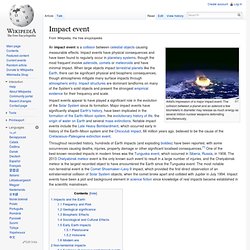
The collision between a planet and an asteroid a few kilometers in diameter may release as much energy as several million nuclear weapons detonating simultaneously. An impact event is a collision between celestial objects causing measurable effects. Impact events have physical consequences and have been found to regularly occur in planetary systems, though the most frequent involve asteroids, comets or meteoroids and have minimal impact. When large objects impact terrestrial planets like the Earth, there can be significant physical and biospheric consequences, though atmospheres mitigate many surface impacts through atmospheric entry.
Impact structures are dominant landforms on many of the System's solid objects and present the strongest empirical evidence for their frequency and scale. Impact events appear to have played a significant role in the evolution of the Solar System since its formation. Vredefort crater. Vredefort crater is the largest verified impact crater on Earth, more than 300 km across when it was formed.[1][2] What remains of it is located in the present-day Free State Province of South Africa and named after the town of Vredefort, which is situated near its centre.
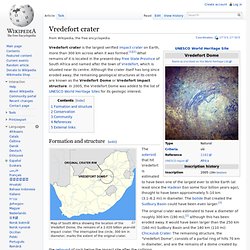
Although the crater itself has long since eroded away, the remaining geological structures at its centre are known as the Vredefort Dome or Vredefort impact structure. In 2005, the Vredefort Dome was added to the list of UNESCO World Heritage Sites for its geologic interest. Formation and structure[edit] Map of South Africa showing the location of the Vredefort Dome, the remains of a 2.020 billion year-old impact crater. The interrupted line circle, 300 km in diameter, marks the extent of the original crater. The original crater was estimated to have a diameter of roughly 300 km (190 mi),[2] although this has been eroded away. Conservation[edit] Sudbury Basin. Geological map of the Basin.
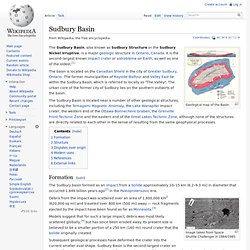
The Sudbury Basin, also known as Sudbury Structure or the Sudbury Nickel Irruptive, is a major geologic structure in Ontario, Canada. It is the second-largest known impact crater or astrobleme on Earth, as well as one of the oldest.[1] The basin is located on the Canadian Shield in the city of Greater Sudbury, Ontario. The former municipalities of Rayside-Balfour and Valley East lie within the Sudbury Basin, which is referred to locally as "The Valley". The urban core of the former city of Sudbury lies on the southern outskirts of the basin. The Sudbury Basin is located near a number of other geological structures, including the Temagami Magnetic Anomaly, the Lake Wanapitei impact crater, the western end of the Ottawa-Bonnechere Graben, the Grenville Front Tectonic Zone and the eastern end of the Great Lakes Tectonic Zone, although none of the structures are directly related to each other in the sense of resulting from the same geophysical processes.